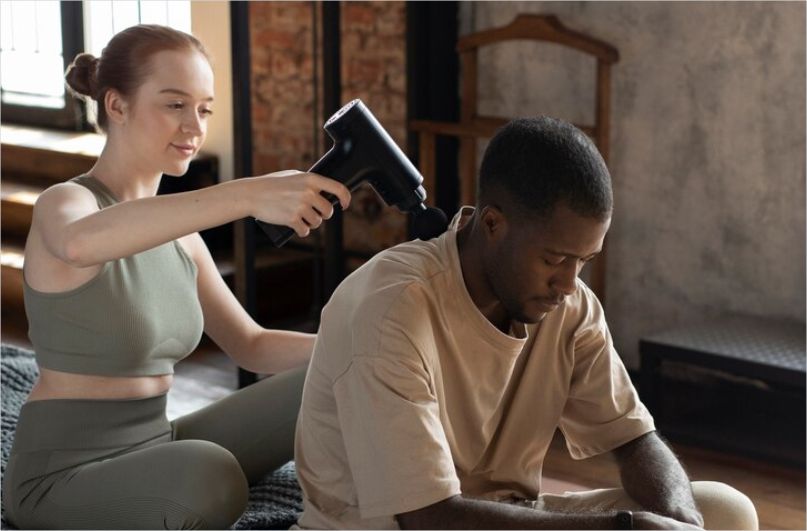Last updated on April 19th, 2025 at 08:46 am
Exploring BDSM, Kink and Fetishim as a beginner can be an exciting journey, but it’s important to prioritize safety and consent. Here is how.
If you’re just starting, take the time to learn about boundaries, communication, and the different dynamics within BDSM.
Educate yourself on tools, roles, and practices before trying anything new.
Open, honest conversations with your partner about limits and desires will help build trust.
It’s not just about the physical experience, but also about mental and emotional readiness.
As you explore, focus on mutual respect and understanding. This guide will walk you through the basic steps to safely explore BDSM.
Recommended: BDSM Tools and Equipment
Table of Contents
- How to Start with BDSM as a Beginner
- Start with Basic BDSM, Kink, and Fetish Practices
- Educate Yourself
- Choosing Safe and Quality BDSM Equipment
- Establishing Aftercare Routines
- Know Your Limits
- Seek Professional Advice When Needed
- Frequently Asked Questions
- Conclusion
How to Start with BDSM as a Beginner
Understand Consent and Communication
Before exploring BDSM, it’s crucial to grasp the importance of communication and consent.
Openly discuss desires, limits, and comfort levels with your partner before engaging in any activities.
This ensures both of you are on the same page and creates a foundation for a safe, enjoyable experience.
See a comprehensive guide on consent, consent forms, and contracts.
The Role of Safe Words
A key part of communication in BDSM is establishing safe words. Safe words act as a signal to pause or stop at any time, even if ongoing consent is present.
Using terms like “red” to stop immediately and “yellow” to slow down can help you both navigate the experience safely.
These words respect both partners’ emotional and physical boundaries.
Establishing Boundaries
Every person has their own set of boundaries, and it’s vital to discuss these in depth.
Whether it’s specific acts or potential triggers, being clear about what is on or off-limits is a must.
This conversation helps avoid misunderstandings and ensures mutual respect.
Enthusiastic Consent
Consent isn’t just about saying yes, it’s about enthusiastic participation from both partners.
Ensuring that consent is continuously reaffirmed throughout the experience builds trust and maintains a safe atmosphere.
A healthy BDSM dynamic requires both partners to feel comfortable and confident in their choices.
By prioritizing clear communication, boundaries, and consent, you create a space where both partners can safely enjoy BDSM, Kink and Fetishism.
This approach protects your emotional and physical well-being, making the experience not only enjoyable but fulfilling.
Related: Aftercare: Why You Should Take it Seriously
Start with Basic BDSM, Kink, and Fetish Practices

Starting your journey into BDSM, Kink and Fetishism can feel exciting, but it’s important to approach it with caution.
As a beginner, you’ll want to take things slow, focusing on safety, communication, and trust.
By beginning with basic BDSM practices, you’ll build a strong foundation that allows you to explore further with confidence.
Light Bondage: A Good Starting Point
Light bondage is a great entry point. It’s simple and involves using soft materials like silk scarves, ropes, or bondage tape to gently restrain your partner.
This method allows you to explore control and submission in a comfortable, safe way.
But always communicate with your partner beforehand—set safe words or signals to ensure you both feel in control and secure.
Impact Play: A Beginner-Friendly Exploration
Impact play, which includes practices like spanking or light flogging, is another beginner-friendly area of BDSM.
When starting, it’s best to go slow, gentle impact play with your hands or soft paddles will help you gauge what feels good for both of you.
Keep the conversation going during the experience to make sure you’re both comfortable.
Checking in on each other’s boundaries is crucial, as each person may react differently.
Building Trust Over Time
As you continue exploring, trust and comfort will grow, and you may feel more open to trying new practices.
Pay close attention to your partner’s responses, checking in about comfort levels and limits often.
This helps ensure both of you feel safe and excited during the experience.
By starting with light bondage and gentle impact play, you can gradually expand your exploration while prioritizing mutual respect and communication.
Related: How the Dominant and Submissive tests
Educate Yourself
If you’re thinking about exploring BDSM, the first step is education.
Understanding the practices, safety measures, and the dynamics involved is key to having a responsible and enjoyable experience.
Knowledge not only boosts your confidence but also ensures everyone stays safe.
Start with Research
Begin by looking into reputable resources such as books, websites, and instructional videos.
Focus on materials written by experienced practitioners or educators in the BDSM community.
These will provide valuable insights into consent, communication, and aftercare, all of which are central for building a healthy BDSM relationship.
You’ll also learn about the different types of BDSM, which helps you understand what interests you.
Learn from Workshops and Seminars
Attending workshops or seminars can give you hands-on experience.
Many communities offer classes that cover BDSM techniques, safety protocols, and the psychological side of BDSM.
These events allow you to ask questions and learn directly from experts. It’s a practical way to build knowledge and get answers in real time.
Join Online Communities
Online forums and social media groups are great places to expand your understanding.
By engaging in discussions, you’ll expose yourself to various perspectives, tips, and experiences from both beginners and seasoned practitioners.
These communities can clear up misconceptions and provide advice based on real-world experiences.
Keep Learning
BDSM is a journey of exploration, and ongoing learning is part of it.
Whether through books, workshops, or online communities, continue educating yourself to stay safe and informed as you dive deeper into your exploration.
This foundation of knowledge will help you approach BDSM with respect, care, and confidence.
Choosing Safe and Quality BDSM Equipment

When you begin exploring BDSM, Kink, and Fetishism, choosing the right BDSM equipment is crucial to ensure a safe and enjoyable experience.
It might be tempting to use makeshift or household items, but this can lead to unnecessary risks.
Instead, invest in high-quality, purpose-built gear from reputable brands to prioritize safety and build trust with your partner.
Why Quality Matters
Amateur BDSM practitioners might consider using everyday objects, but these can lack the safety features needed for a secure experience.
Stick to equipment designed for BDSM use, like restraints, paddles, or toys made from body-safe materials such as silicone, leather, or stainless steel.
These materials are durable and reduce the chance of allergic reactions, giving you peace of mind while exploring.
Safety Standards and Certifications
Look for BDSM gear that comes with safety ratings or certifications.
Reputable retailers provide details on the testing their products have undergone, ensuring they meet safety standards.
This extra layer of trust allows you to focus on the experience, knowing that the gear you’re using is designed to be safe.
Learn How to Use and Care for Equipment
Understanding how to use and maintain your BDSM tools is key to having a safe, enjoyable experience.
Invest in educational resources to learn how to handle and care for your gear properly.
By making informed choices, you can create a secure environment for exploration and deepen your connection with your partner.
Establishing Aftercare Routines

Aftercare is a crucial part of BDSM that many beginners overlook. Aftercare refers to the physical and emotional support given to everyone involved after a session.
It’s essential for helping both partners feel secure, respected, and cared for, allowing you to recover from the intensity of the experience.
Understand What You Need for Aftercare
Aftercare can look different for everyone. Some people need verbal reassurance, gentle touch, or cuddling, while others might prefer time alone to decompress.
Before engaging in a session, discuss what kind of aftercare you both want.
This conversation ensures that you’re on the same page about how you’ll support each other after the experience.
Physical Care and Medical Preparedness
In some cases, aftercare may involve addressing physical needs, such as soreness or abrasions from the session.
Having a first aid kit handy can help with minor injuries and shows that you’re thinking ahead about safety.
Taking care of each other physically after a BDSM session is just as important as the emotional care that follows.
Know Your Limits
When starting your journey into BDSM, it’s important to know your limits.
Understanding your physical, mental, and emotional boundaries will help ensure a safe and enjoyable experience for both you and your partner.
Physical Limits
Your physical limits involve how much pain, restraint, or intensity your body can handle.
Everyone has different tolerances, so it’s crucial to talk openly with your partner about your comfort levels, any past injuries, or health conditions that may affect what you’re willing to try.
Mental Limits
Mental limits are about your readiness for certain activities, like role-playing or power dynamics.
Be clear with yourself and your partner about what you’re comfortable with. If something feels off or triggers discomfort, that’s okay.
A safe word is key here. It gives you a way to stop everything instantly if you need to, ensuring both parties feel respected and safe.
Emotional Limits
Emotional limits impact how you feel during and after a BDSM session.
Regular check-ins with your partner can help assess emotional comfort levels.
Whether through verbal communication or non-verbal cues, make sure both of you feel heard and understood throughout the experience.
Seek Professional Advice When Needed
When you’re new to BDSM, it’s normal to feel both excited and uncertain.
One of the most important steps you can take is seeking professional advice.
Experienced practitioners or educators in the BDSM community can guide you through any uncertainties you might have about practices, safety, or aftercare.
Learning from Workshops and Classes
Many cities offer BDSM workshops, classes, and discussion groups led by seasoned professionals.
These events allow you to learn directly from experts, ask questions, and connect with others who share your interests.
This hands-on learning can help you gain confidence and a deeper understanding of BDSM dynamics, including trust, consent, and communication.
Online Resources for Self-Study
If attending in-person events isn’t possible, there are plenty of reputable online platforms offering valuable content on BDSM practices.
Articles, podcasts, and forums provide insights that can help you learn at your own pace.
However, always make sure you’re using credible sources to avoid misinformation that could lead to unsafe experiences.
Frequently Asked Questions
What should beginners prioritize when exploring BDSM?
Beginners should prioritize safety, consent, communication, and understanding boundaries to ensure a safe and enjoyable experience.
What is the role of safe words in BDSM?
Safe words signal when to pause or stop an activity, ensuring that both partners’ emotional and physical boundaries are respected.
How can beginners start exploring BDSM safely?
Beginners can start with light bondage and gentle impact play while focusing on communication, trust, and safety.
Why is aftercare important in BDSM?
Aftercare provides emotional and physical support, helping partners recover and ensuring mutual respect after a session.
Conclusion
Exploring BDSM as a beginner can be both exciting and intimidating.
Safety, education, and consent are critical to ensuring a positive experience.
Understanding safe words, risk-aware consensual kink, and physical safety measures helps establish a solid foundation.
Clear, enthusiastic, and ongoing consent is essential, along with open communication about boundaries and limits.
Education, through workshops, literature, and online communities, provides valuable insights into practices and safety.
Aftercare, offering emotional and physical support, is crucial for recovery and emotional well-being.
By prioritizing safety, consent, communication, education, and aftercare, beginners can enjoy safe and fulfilling BDSM experiences.

